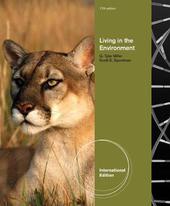
|
Living in the Environment, International Edition
Paperback
Main Details
| Title |
Living in the Environment, International Edition
|
| Authors and Contributors |
By (author) Scott Spoolman
|
|
By (author) G. Miller
|
| Physical Properties |
| Format:Paperback | | Pages:784 | | Dimensions(mm): Height 276,Width 229 |
|
| Category/Genre | Ecological science
The environment |
|---|
| ISBN/Barcode |
9780538735353
|
| Classifications | Dewey:333.7 |
|---|
| Audience | | Tertiary Education (US: College) | |
|---|
| Edition |
17th edition
|
|
Publishing Details |
| Publisher |
Cengage Learning, Inc
|
| Imprint |
Brooks/Cole
|
| Publication Date |
1 January 2011 |
| Publication Country |
United States
|
Description
Learn how to make a difference in our environment! Using sustainability as the central theme, this current and thought-provoking book provides you with basic scientific tools for understanding and thinking critically about the environment and the environmental problems we face. Updated with new information, art, and "Good News" examples, this engaging book offers vivid case studies and hands-on quantitative exercises. The concept-centered approach transforms complex environmental topics and issues into key concepts that you will be able to understand and remember. Overall, by framing the concepts with goals for more sustainable lifestyles and human communities, authors G. Tyler Miller and Scott Spoolman enable you to learn and implement useful environmental solutions and see how promising the future can be.
Author Biography
G. Tyler Miller has written 62 textbooks for introductory courses in environmental science, basic ecology, energy, and environmental chemistry. Since 1975, Miller's books have been the most widely used textbooks for environmental science in the United States and throughout the world. They have been used by almost three million students and have been translated into eight languages. Miller has a professional background in chemistry, physics, and ecology. He has a PhD from the University of Virginia and has received two honorary doctoral degrees for his contributions to environmental education. He taught college for 20 years, developed one of the nation's first environmental studies programs, and developed an innovative interdisciplinary undergraduate science program before deciding to write environmental science textbooks full time in 1975. Currently, he is the president of Earth Education and Research, which is devoted to improving environmental education. Scott Spoolman is a writer and textbook editor with more than 30 years of experience in educational publishing. He has worked with Tyler Miller since 2003 as a contributing author on editions of LIVING IN THE ENVIRONMENT, ENVIRONMENTAL SCIENCE, and SUSTAINING THE EARTH. With Norman Myers, he also coauthored ENVIRONMENTAL ISSUES AND SOLUTIONS: A MODULAR APPROACH. Spoolman holds a master's degree in science journalism from the University of Minnesota. He has authored numerous articles in the fields of science, environmental engineering, politics, and business. He worked as an acquisitions editor on a series of college forestry textbooks. He has also worked as a consulting editor in the development of over 70 college and high school textbooks in fields of the natural and social sciences. In his free time, he enjoys exploring the forests and waters of his native Wisconsin along with his family- his wife, environmental educator Gail Martinelli, and his children, Will and Katie.
ReviewsPART I: HUMANS AND SUSTAINABILITY: AN OVERVIEW. 1. Environmental Problems, Their Causes, and Sustainability. PART II: SCIENCE, ECOLOGICAL PRINCIPLES, AND SUSTAINABILITY. 2. Science, Matter, Energy, and Systems. 3. Ecosystems: What Are They and How Do They Work? 4. Biodiversity and Evolution. 5. Biodiversity, Species Interactions, and Population Control. 6. The Human Population and Its Impact. 7. Climate and Biodiversity. 8. Aquatic Biodiversity. PART III: SUSTAINING BIODIVERSITY. 9. Sustaining Biodiversity: The Species Approach. 10. Sustaining Terrestrial Biodiversity: The Ecosystem Approach. 11. Sustaining Aquatic Biodiversity. PART IV: SUSTAINING NATURAL RESOURCES. 12. Food, Soil, and Pest Management. 13. Water Resources. 14. Geology and Nonrenewable Minerals. 15. Nonrenewable Energy. 16. Energy Efficiency and Renewable Energy. PART V: SUSTAINING ENVIRONMENTAL QUALITY. 17. Environmental Hazards and Human Health. 18. Air Pollution. 19. Climate Change and Ozone Depletion. 20. Water Pollution. 21. Solid and Hazardous Waste. 22. Sustainable Cities. PART VI: SUSTAINING HUMAN SOCIETIES. 23. Economics, Environment, and Sustainability. 24. Politics, Environment, and Sustainability. 25. Environmental Worldviews, Ethics, and Sustainability. SUPPLEMENTS. 1. Measurement Units. 2. Reading Graphs and Maps. 3. U.S. Environmental History. 4. Some Basic Chemistry. 5. Classifying and Naming Species. 6. Components and Interactions in Major Biomes. 7. Weather Basics, El Nino, Tornadoes, and Tropical Cyclones. 8. Maps. 9. Environmental Data and Data Analysis.
|